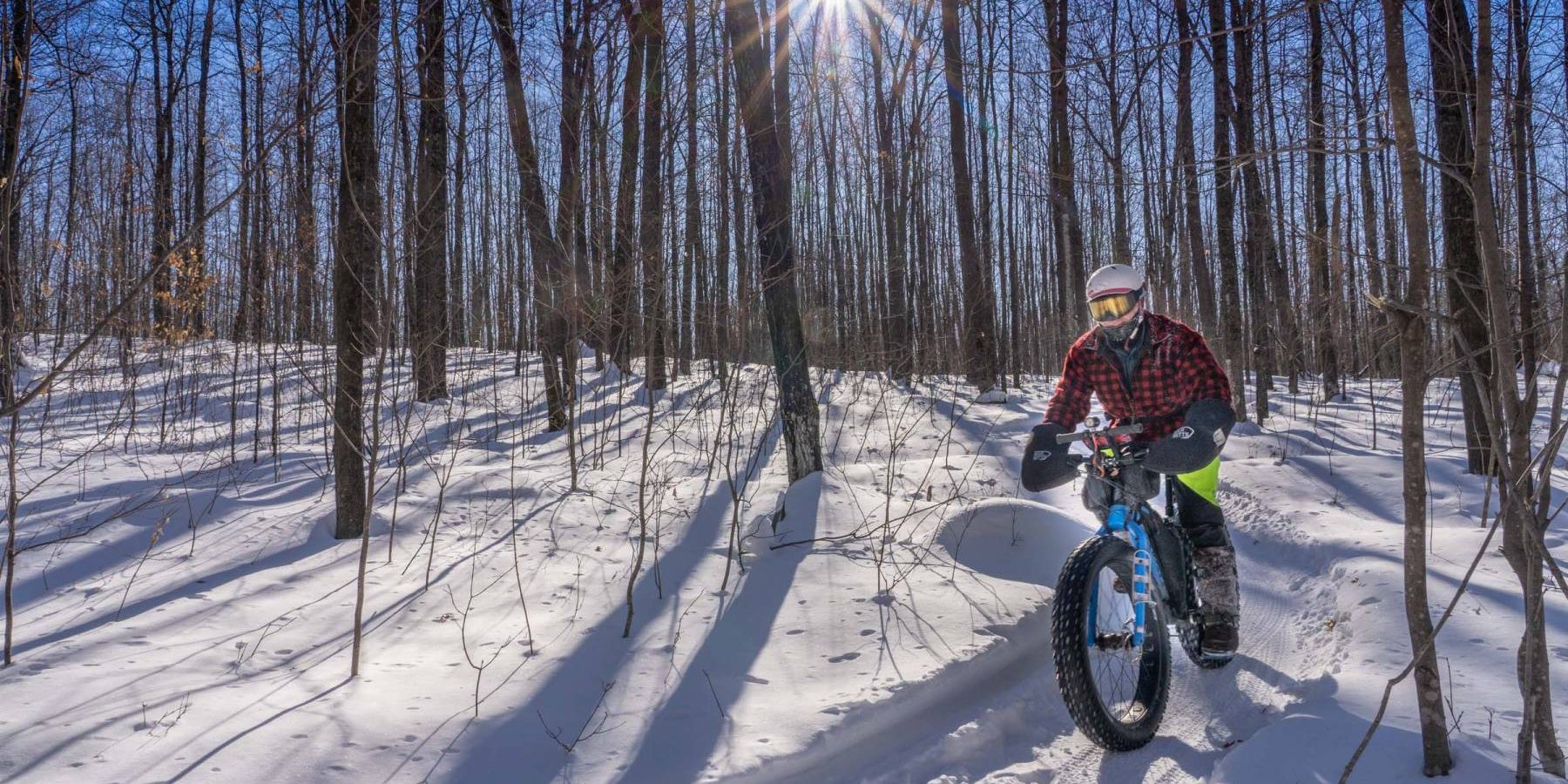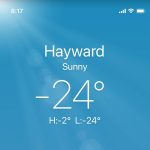 Perhaps it is because I am from way down south (the south side of Milwaukee that is), but I have always romanticized winter. If I was forced to walk to a two-hole outhouse as a kid, as my Butternut-area deer hunting buddy was, I might have spent more time visiting Arizona and moved there after I semi-retired. Whatever the reason, I love the cold. The goofy TV show Life Below Zero is one of my guilty pleasures when I am not planning or executing some cold-weather adventure in Wisconsin’s Northwoods.
Perhaps it is because I am from way down south (the south side of Milwaukee that is), but I have always romanticized winter. If I was forced to walk to a two-hole outhouse as a kid, as my Butternut-area deer hunting buddy was, I might have spent more time visiting Arizona and moved there after I semi-retired. Whatever the reason, I love the cold. The goofy TV show Life Below Zero is one of my guilty pleasures when I am not planning or executing some cold-weather adventure in Wisconsin’s Northwoods.
So when the forecast predicted temperatures of -18° F, I began scheming some short trips with my dog Cowboy to ride gravel fire roads and photograph frozen waterfalls. And I even went to bed the night before the coldest night planning to get up early to take full advantage of the sub-zero temperatures with a morning fat bike ride on the neighborhood trails in Seeley.
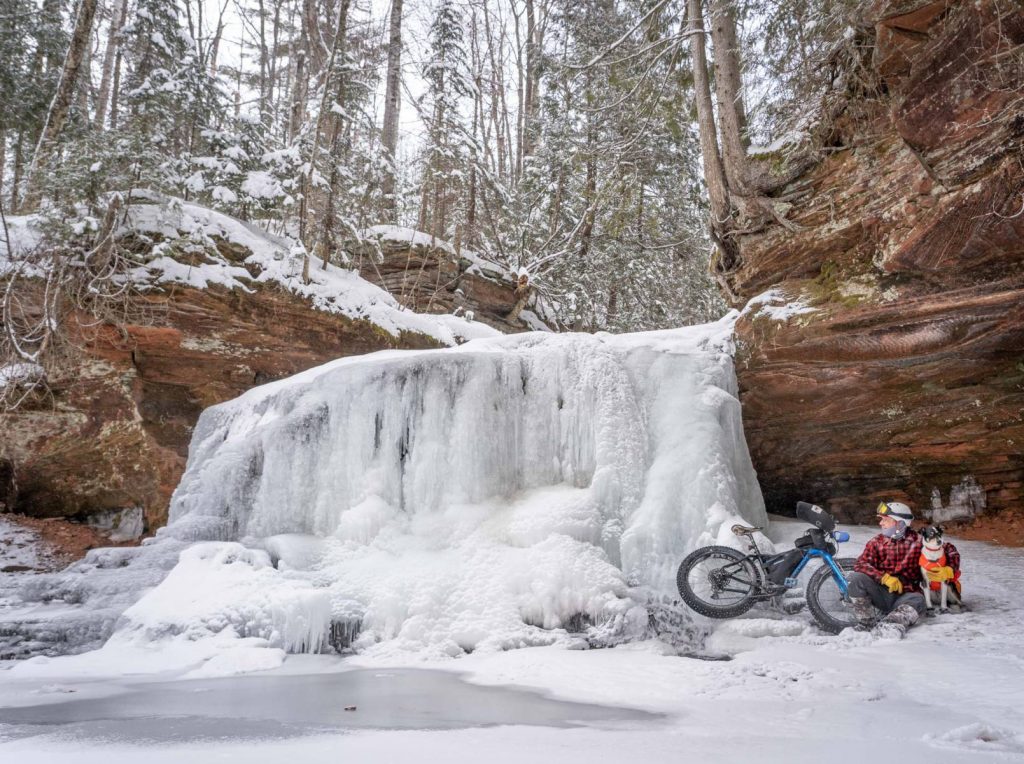
In the very cold, Cowboy wears a jacket and booties made by Affordable Dog Sleds, just down the road from me in Seeley.
Imagine my joy when Cowboy woke me up around 5:30 am to let him out and I checked the weather: 24 below zero! By the time I had made coffee, took a shower (fully dried my hair), got my camera gear together, put on a cold-weather outfit, and headed out to the garage to get my Salsa Mukluk, it was only a little after 8 am, but the temps were still -24°F. As I slowly pedaled off for the Seeley Winter Trails, the sun was shining and my neck gaiter hid a big grin on my face.
I only rode for a couple of hours including stops for photos and to record a Seeley Dave hyperborean trail report. By the time I got back to my garage, I was actually a little sweaty, something I strive to avoid on longer or multi-day winter bikepacking trips. Finishing a ride sweaty when you still need to build a fire and set up camp makes it very difficult to stay warm. Once those wet layers start to get cold, they compete with your inner warmth. And as we all know, nature usually wins.
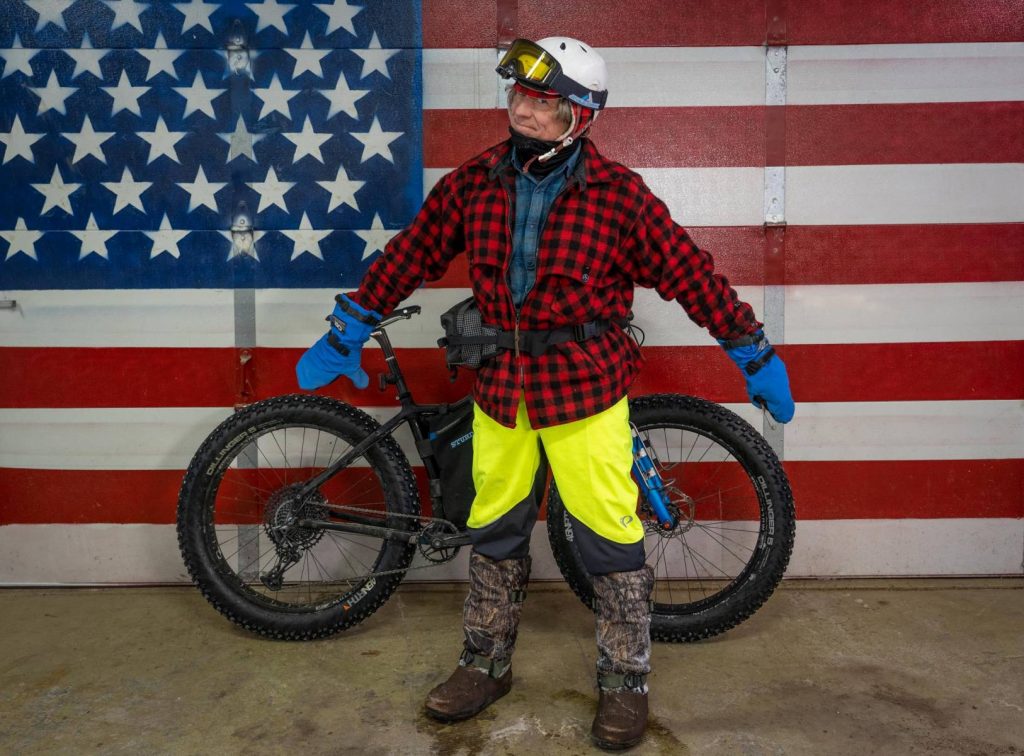
My full outfit for a ride when it is -24° F. See the text below for details.
But that sort of careful balance of layering, breathability and insulation is really only critical if you won’t finish your ride with a warm house to go into. For day rides, it remains important to dress so you are not cold and don’t get too hot, but finishing a ride a little sweaty is no big deal when you can turn the seat heater on and drive home. Still, the extreme cold like our recent weather seems to keep many people from venturing out. So I thought I would share some of my tips and tricks for dressing for cold weather rides. There are LOTS of other ways to do this, and I don’t claim my way is better than anybody else’s. These are just what I find works for me. It should also be stated at the outset, that while I embrace modern fabrics and technology, I prefer to ride in clothes that I can also wear without attracting too much attention after the ride when I make a stop at Rondeau’s.
I’ve said I own so much flannel that my belly button is plaid, but actually, I tend to wear a solid merino wool long sleeve henley or turtle neck as my top base layer. I just wear regular quick-dry underwear, not long johns down below. On my feet, I wear Wisconsin-made Wigwam Avondale over-the-calf socks, with a thicker pair of Wigwam wool socks over those depending on the outside temperatures.
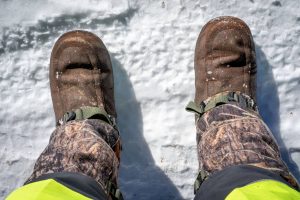
The Stieger CamuksXtreme that I wear hunting and ice fishing.
For the outer layers, beginning at my feet, I either wear the same pair of Stieger Camo Mukluks I wear deer hunting, or I wear a pair of Keen Summit County Boots. If I know I will be riding on a lot of ice, I will either put some short, hex-head sheet metal screws in the bottom of my boots or if it isn’t too cold, wear a pair of Icebug zip-up boots I mostly use for walking around my driveway after it turns to a sheet of ice. The key is to have comfortable boots that don’t slip on flat pedals, with enough room for the socks so they don’t squeeze your feet. You need to trap warm air in your boots.
For pants, I am in love with Swrve Winter Trousers. They look like regular pants, but are made with a soft-shell exterior and brushed fleece inside. I wear them every day, all winter long. They are not waterproof but close to it. When the temperatures are extremely low, like they were recently, I slip on a pair of Pearl Izumi rain over shorts. They provide extra protection for your critical areas and also allow you to sit down in the snow without worrying about getting your pants wet. That is a big bonus on winter bikepacking trips when you spend a lot of time sitting around a campfire.
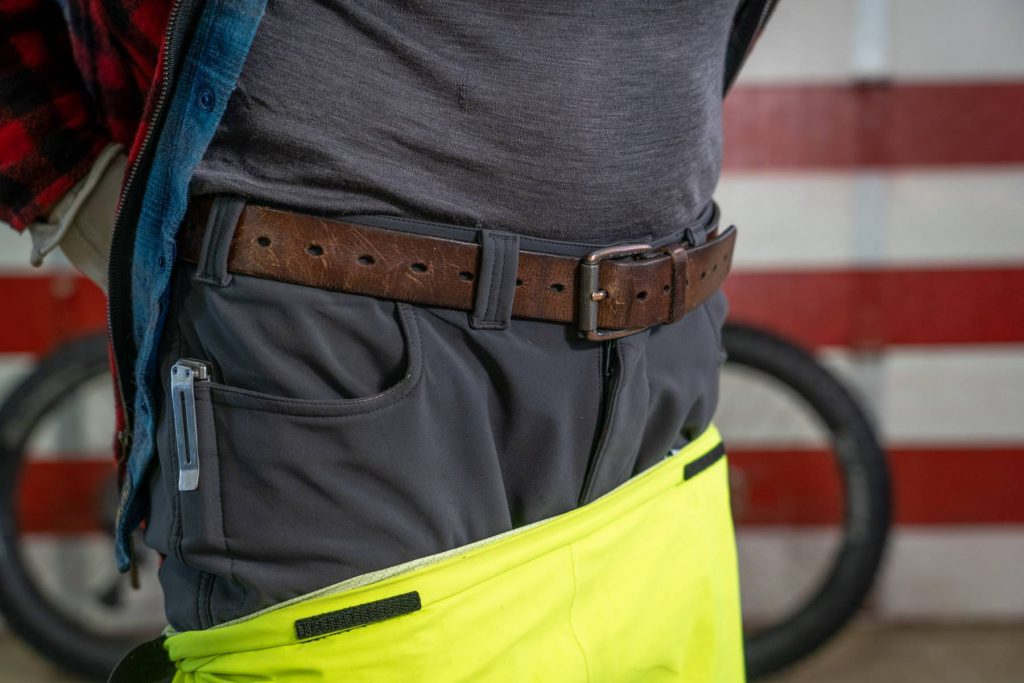
My grey Swrve Winter Trousers (bonus knife pocket), rain shorts, and merino wool long sleeve base layer on my torso.
My next layer on my torso is typically a flannel shirt of some kind. My favorites are the Kitsbow Icon, made in the USA from MUSA Pendleton wool, but with bike-centric modern features like gussets at the back shoulders, snap buttons, and softshell accents. These shirts are VERY expensive when you can find used Pendletons at vintage stores for $35, but if you ride a lot, it is worth investing in one. I think they will last forever, and they honestly do fit better on the bike than a regular flannel.
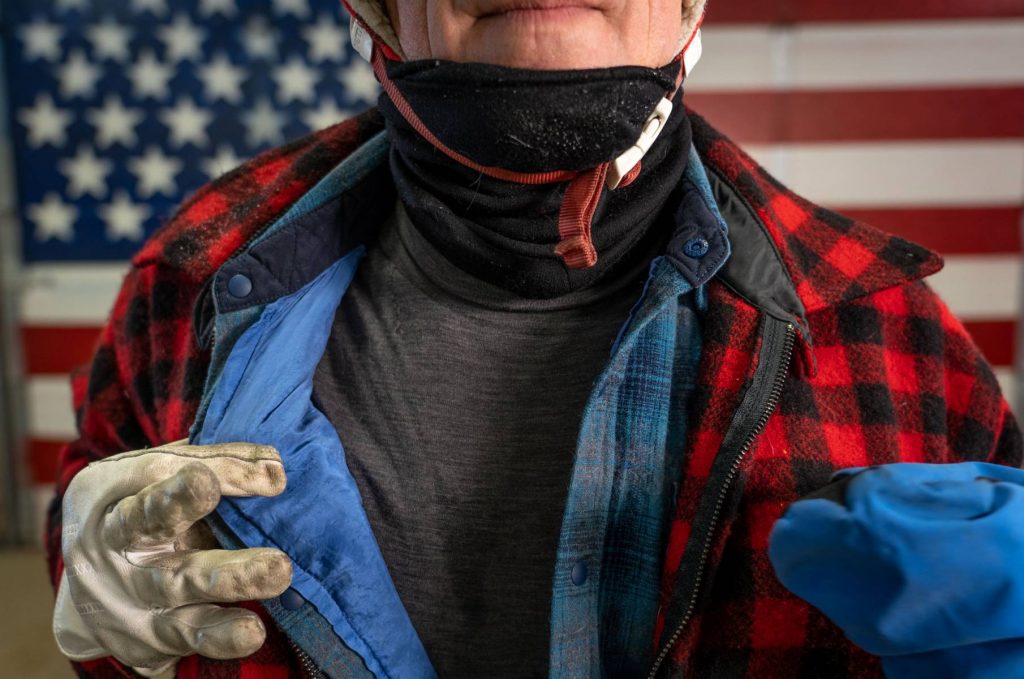
You can see all three torso layers here, including the blue silk wind block liner I sewed into my Kitsbow Icon flannel shirt. You can also see the leather work gloves I wear under the blue overmitts and the neck gaiter over my chin.

When I just bring thin gloves and overmitts, I carry these packable down mittens with me as emergency back-up. For this ride I stuffed them in my jacket chest pockets.
I did make one DIY modification to my Kitsbow Icon. I sewed a silk liner in the front as a wind block. Having a breathable second layer is critical, but my chest gets cold and chapped if I ride without some wind protection. And my outer-layer of choice for cold weather is my vintage Johnson Woolen Mills red plaid jacket. It sheds light rain and melting snow, breathes incredibly well, never needs washing, keeps me warm, and I don’t have to be too careful reaching into a campfire to move a log or grab my water.
Moving up to the neck, I either wear a thin buff or a wool neck gaiter. I find that if my neck and chin are covered, I feel way warmer than if they are not, no matter how many thick layers I am wearing on my torso. On my head, I wear an old red plaid wool Cognition hat made in Madison. It is very thin wool on top, so it is very breathable but has fleece ear and forehead covers. The forehead cover is key, just like the gaiter over my chin and neck. You can fold up the ear covers in warmer weather, and the hat fits really well under a helmet.
One little DIY hack I do is to put some electrical tape with a thin layer of fleece stuck to it on my goggles to keep my nose covered, for any other exposed flesh on my face, like my lips and cheeks, I put some petroleum jelly on them before I head out.

Note the electrical tape I put over the nose of my goggles to keep my nose warm.
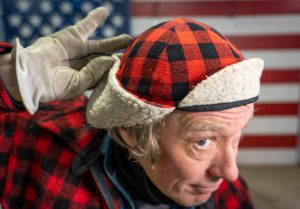
Boy I hope I never lose this Cognition hat. I don’t think they make this one anymore.
Finally, we come to the hands. I have lots of gloves and mittens, most of which I got at the hardware store. I prefer leather because I can grab hot things in the fire without them melting. When temperatures are super cold, but I know I plan on needing the dexterity to take photos, I wear a thin pair of deerskin leather gloves without insulation inside a pair of Outdoor Research non-insulated overmitts. Note I always have Barmitts Extreme pogies on my bikes during the winter, so that makes it easier to keep my fingers warm. For emergencies, I tend to keep a pair of Outdoor Research down mittens stuffed in my pockets or bike bags. If I break down and have to keep my fingers outside for longer than is ideal, I can slip these on and get warm quickly. They pack tiny, but they won’t hold up to riding and you surely can’t reach into the campfire with them on.
I hope this helps people who want to get out and ride when it is below zero but are unsure of how to do it without freezing. Again, there are lots of other ways to dress for cold and exercise, this is just what I find works for me, fits my style, and allows me to save some money because I can wear this stuff for hunting, ice fishing, snowshoeing, or just going into town. For those who suffer from Renaud’s Syndrome, I have friends who swear by modern battery-powered heated insoles and gloves.
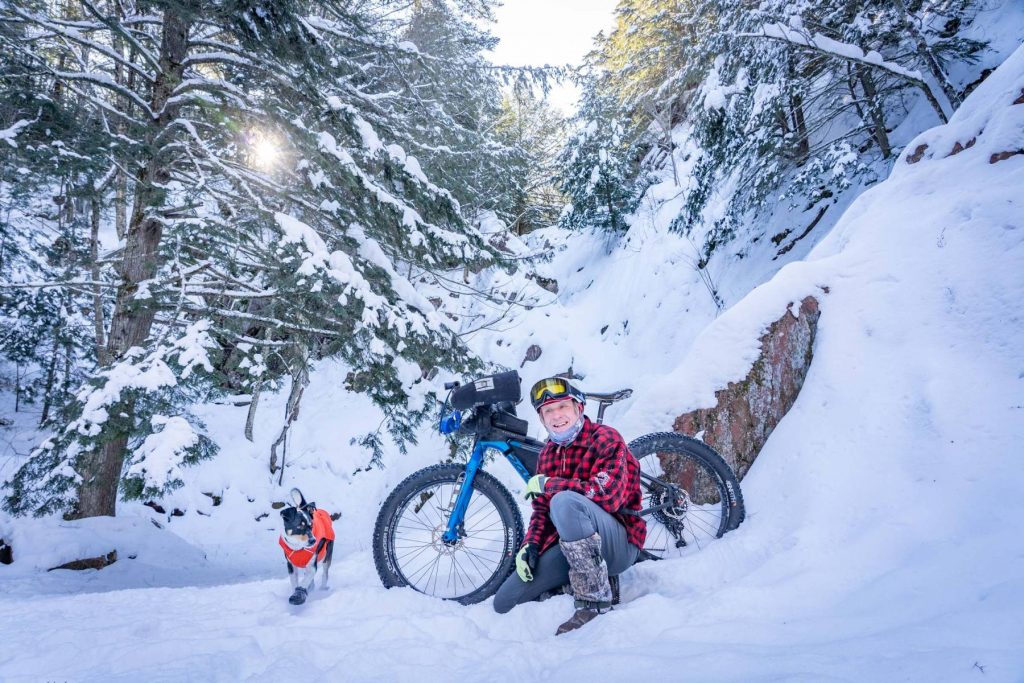
Now get out there and have a winter adventure!


